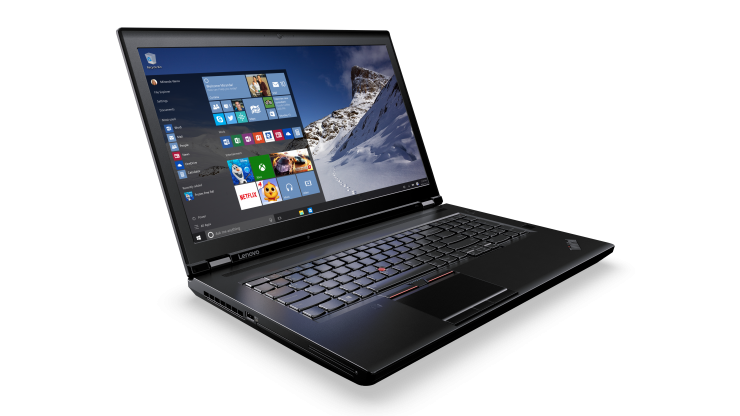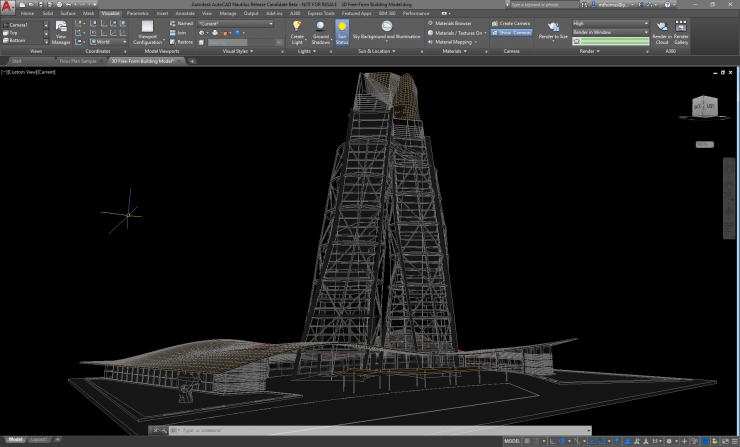ThinkPad P70 – Power of a Tower, Now on the Move
I was very fortunate to have been provided a Lenovo ThinkPad P70 to test for a couple weeks, which although I don’t get to keep it still felt like Christmas morning when it showed up. The P-series of ThinkPad’s are built for professionals. They offer the highest performance that Lenovo can possibly pack into a mobile unit. The P70 series was created for designers, engineers, and artists needing the mobility of a laptop but yet the most horsepower (CPU & GPU) possible.

Key Features
- Intel Xeon Mobile Processors
- NVIDIA Quadro GPU and 4K Display
- ISV Certified
- FLEX Performance Cooling System
- 17″ Mobile Workstation
These units can hold up to 64-GB RAM and 2TB in SSD storage, These ThinkPad’s provide faster access to your stuff (compared to past models) due to upgraded I/O bandwidth and enhancements to support the latest NVMe PCIe (3rd generation) storage drives. These units have ECC Memory support and Thunderbolt 3 ports,
Dimensions (W x D x H)
- (mm) : 416 x 275.5 x 29.9 – 31.5
- (inches) : 16.4″ x 10.8″ x 1.17″ – 1.2″
Display
- FHD (1920 x 1080) IPS, 300 nits
- FHD Touch (1920 x 1080) IPS, 270 nits
- 4K UHD (3840 x 2160) IPS, 300 nits
Weight
- Starting at 7.6 lbs (3.4 kg)
Lenovo worked hard to build them tough, pack em full of tech, but yet keep the weight down. However, they are heavy when compared to other laptops. As a 17″ unit they also won’t fit into a standard laptop bag (nor the safe in the hotel room I recently stayed in), but that’s the trade-off for the bigger viewing area.
The Unit – First Impressions
The first thing I noticed as I was taking it out of the box is that these units are built tough. The ThinkPad P70 passes eleven MIL-STD 810G military certification tests. Lenovo also puts these units through a series of in-house tests, including vibration & bump tests, LCD stress tests, drops, dust, and more. The unit feels rigid like I could drop it down a flight of stairs and it would come up fighting (and no this didn’t actually happen).
The system I tested…
- Windows 10 (64-bit)
- Intel Xeon E3-1505M v5 @ 2.8GHz
- Quadro M4000M (4GB)
- 16 GB 2133MHz DDR4 ECC RAM
- 512GB Samsung NVMe PCLe M.2 SSD
- 17.1” 4K UHD IPS (up to 3840×2160)
The P-series units are ISV Certified. If you are not familiar with ISV certification, Independent software vendors (ISVs) are software companies who test computer systems to ensure software and hardware compatibility, stable and reliable operation, and that the highest level of support can be provided.
Surprising to me is that it takes almost a full minute for the Thinkpad P70 to boot from cold (53-seconds to be specific), which with the hardware, especially the SSD, seems long. The longest part is the pause at the Lenovo splash screen, it is obviously loading something or is it pausing for dramatic effect?
I’m not a fan of the softer charcoal finish. It was full of fingerprints before I even got the unit out of the packaging. I much prefer the metallic finish of other laptops that are more resistant to scratches and my fingerprints.
Hardware
“A new standard in processing power”
The ThinkPad P Series are one of the first to ship with the new Intel Xeon Processors, made specifically for mobile workstations. I like the tagline… “Power of a tower, now on the move.” But it’s not just the processor that’s fast… throw in the latest and greatest from NVIDIA (with Maxwell-based GPUs), DDR4 ECC RAM, and a kickass SSD (utilizing the latest PCLe technology) and this unit rocks-and-rolls.

“Vibrant images that make an impression”
The second thing you’ll notice with the Thinkpad P70 is the graphics. The colours and the sharpness are unbelievable and truly impressive. The white is so impressive, it just pops off the screen. Watching Netflix and using Inventor never looked so good!
I’m a 4K virgin as this was my first time getting to significantly use a system with 4K support. I will admit that the high resolution (3840 x 2160) was a bit too much to work with using the built-in display. This is not a knock against Lenovo, but I ended up finding 1920 x 1200 was the best for me. Here’s what Inventor 2017 looks like at 3840 x 2160

The ThinkPad P Series ships including the X-Rite Pantone color calibration. What an interesting process. You actually shut the lid, wait for the series of beeps to finish, and voila, colour is calibrated. You do this process semi-regularly (the default I believe is weekly), which supposedly keeps the colors accurate and consistent.
FLEX Performance Cooling
Lenovo put in a dual-fan cooling system in the P-series, called FLEX Performance Cooling. They claim it allows for the system to run cooler, quieter, and faster. It is definitely quieter than the older HP unit I have, and significantly quieter than the mutt of a home system the kids use. The unit also never gets hot. I did some “heavy lifting” with Inventor… larger assembly, rendering, drawings, etc, and there was no noticeable increase in surface temperature. It’s also surprisingly quiet, like really quiet.

With two fans (dynamic cooling) you can push the system but not feel the heat. With two fans it also means if one fan quits the unit will continue with one (Great redundancy).
The Unit
The keyboard has an almost old-school mechanical typewriter feel. Which at first feels weird, but after using it for a while I really like it. To me, it’s like comparing the keyboard on a blackberry to that of an iPhone or Android phone. The tactile style makes it easy to know where you are on the keyboard, and the spring back of the keys make it easy to know what you have typed. After using it for a bit it was hard to go back to the keyboards on the other laptops I use.
But why-oh-why Lenovo do you continue to put the Function key in the bottom left corner! This should be Ctrl… always, no exceptions! To make matters worse there are situations where the Ctrl works as the Function and the Function key as Ctrl…. arghhh, this doesn’t help!
Plenty of connections on the unit, including 2 Thunderbolt 3 ports.
- 2 x Thunderbolt 3 (USB-C)
- 1 x HDMI out
- 1 x Gigabit Ethernet
- 1 x Smart Card Reader
- 4 x USB 3.0 (one always on)
- 1 x Mini Display Port
Fairly standard three button laptop touchpad, except for the “crystal silk” material. It is advertised as providing resistance to wear while providing a smooth effortless experience. I’d describe it as smooth without being slippery. I’m not a huge fan of laptop pads, really only use them when absolutely necessary, but I did find this one effortless to use.

Inventor 2017
I was very impressed by how Inventor performed with 4K. All the dialogs appear to scale properly, unlike many Windows dialogs that open extremely small.
As a comparison, I performed a few operations on both the P70 and a will-remain-nameless laptop. The nameless laptop is running Windows 10 (64-bit), Nvidia K4100M (4GB), 32-GB RAM, and an Intel Core i7-4800MQ @ 2.70GHz.
The first test was opening a 5000-component assembly with Inventor 2017 on both systems. The P70 opened it in about 60% of the time of the other laptop.
Here is a model on the nameless laptop, with Raytracing enabled (highest quality), after letting it process for 300-seconds

Here is the same model on the P70, Raytracing enabled, highest quality, after 200-seconds

Can you see the difference? Probably not, but take note that the image took a 1/3 less time to complete on the P70. What this doesn’t show is that I created the image while the P70 was at its max resolution, in all its 4K glory. The screenshot does not do justice on how much better it looked either.
The same model in draft raytrace mode the P70 was able to complete the view in 85-seconds compared to 189 for the nameless laptop.
Another example… I used Inventor Studio to render the dishwasher model. I configured it to render for 4-minutes. The P70 was able to get almost twice the iterations in (112 vs 198)


In Review
I haven’t talked about the price, but looking online you can purchase a Thinkpad P70 for less than $2000. However the unit I tested lands in the $3500+ range. If you are looking for a mobile workstation. the Lenovo Thinkpad P70 is really the best in class. What do I really like about this system?
- This unit is rock solid, in that it is built tough… built to survive being thrown into a bag and hauled around.
- The tech they packed into the box… this unit rocks and rolls
- The graphics are amazing, truly, even when not in its 4K glory. I really wish I could present how brilliant they are.
- The keyboard… tough to quantify, but its different in a good way
My complaints?
- Lenovo’s insistence to flip the function and ctrl keys
- the fingerprint attracting charcoal finish





